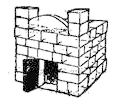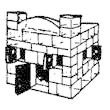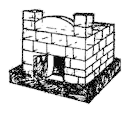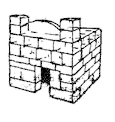Your break begins with executive coach transfer from a regional pick-up point and you travel to Paris via cross-channel ferry and arrive at your hotel in the evening. The Ibis is an excellent quality hotel with private facilities in all rooms: a satellite TV, a radio, a telephone and ban alarm clock.
The following day, after a continental breakfast (included), the coach takes you on a comprehensive sightseeing tour of the city, during which you will see the Eiffel Tower, Champs Elysees, L'Arc de Triomphe, the Louvre, in fact almost every famous landmark you have ever heard of. You then leave Paris and take a short drive to the magnificent Palace of Versailles, the home of Louis XIV. The tour ends mid-afternoon back in Paris where you will have the remainder of the day for your leisure. In the evening there is a "Paris By Night" tour that shows you the beautiful buildings with bright lights.
Day three takes you to Montmartre, perhaps the most charming quarter of Paris and home of the Sacre Coeur and the Moulin Rouge. In the afternoon you are free to explore this beautiful city as you wish, perhaps a pleasure voyage on the River Seine. In the evening you will have the opportunity to visit the best nightclub in the city. On the final day it's time to go back to the UK via channel ferry.
Included in the price of £129 per person are the following:
*Return executive coach travel to Paris
* Return ferry crossings
* 3 nights accommodation in a two-bed room in a Central Paris hotel with private facilities
* Continental breakfast during your stay
* Guided sightseeing tour of "Paris By Day" and "Paris By Night"
* Visit to Palace of Versailles (admission not included)
* Tour on Montmartre
* Services of an experienced tour guide at all times
1. The Ibis is a ________in Paris_
| A.restaurant | B.hotel | C.bar | D.nightclub |
| A.a period of time | B.district | C.the fourth part | D.exhibition |
| A.the continental breakfast |
| B.the tour of Montmartre |
| C.the admission to Palace of Versailles |
| D.the services of an experienced tour guide |
| A.have half a day free on the third day |
| B.have a "Paris By Night" tour on the first evening |
| C.have a pleasure voyage on the River Seine together |
| D.live in a simple hotel far away from Paris |
| A.tell tourists the route to Paris |
| B.inform people about the cost of traveling to Paris |
| C.introduce the city of Paris |
| D.attract tourists to Paris |
2 . Holidaymakers who are bored with baking beaches and overheated hotel rooms head for a big igloo. Swedish businessman Nile Bergqvist is delighted with his new hotel, the world’s first igloo hotel. Built in a small town in Lapland, it has been attracting lots of visitors, but soon the fun will be over.
In two weeks’ time Bergqvist’s ice creation (作品) will be nothing more than a pool of water. “We don’t see it as a big problem,” he says. “We just look forward to replacing it.”
Bergqvist built his first igloo in 1991 for an art exhibition. It was so successful that he designed the present one, which measures roughly 200 square meters. Six workmen spent more than eight weeks piling 1,000 tons of snow onto a wooden base; when the snow froze, the base was removed. “The only wooden thing we have left in the igloo is the front door,” he says.
After their stay, all visitors receive a survival certificate recording their success. With no windows, nowhere to hang clothes and temperatures below 0℃, it may seem more like a survival test than a relaxing (轻松的) hotel break. “It’s great fun,” Bergqvist explains, “As well as a good start in survival training.”
The popularity of the igloo is beyond doubt: it is now attracting tourists from all over the world. At least 800 people have stayed at the igloo this season even though there are only 10 rooms. “You can get a lot of people in,” explains Bergqvist. “The beds are three meters wide by two meters long, and can fit at least four at one time.”
1. Bergqvist designed and built the world’s first igloo hotel because ________.| A.an art exhibition was about to open |
| B.he wanted to make a name for the small town |
| C.he believed people would enjoy trying something new |
| D.more hotel rooms were needed |
| A.hotel guests will be frightened at the thought of the hard test |
| B.a bigger igloo will replace the present one |
| C.holidaymakers will soon get tired of the big igloo |
| D.Bergqvist’s hotel will soon become a pool of water |
| A.to gather a pool of water |
| B.to prepare a wooden base |
| C.to cover the ground with ice |
| D.to pile a large amount of snow |
| A.they have had a taste of adventure |
| B.they have had an ice-snow holiday |
| C.they have had great fun sleeping on ice |
| D.they have visited Lapland |
A. | B. | C. | D. |
For years we made the long drive from our home in Seattle to my parents’ home in Boise in nine hours. We traveled the way most people do: the fastest, shortest, easiest road, especially when I was alone with four noisy, restless kids who hate confinement (限制) and have strong opinions about everything.
Road trips felt risky, so I would drive fast, stopping only when I had to. We would stick to the freeways and arrive tired.
But then Banner, our lamb was born. He was rejected by his mama days before our planned trip to Boise. I had two choices: leave Banner with my husband, or take him with me. My husband made the decision for me.
That is how I found myself on the road with four kids, a baby lamb and nothing but my everlasting optimism to see me through. We took the country roads out of necessity. We had to stop every hour, let Banner shake out his legs and feed him. The kids chased him and one another. They’d get back in the car breathless and energized, smelling fresh from the cold air.
We explored side roads, catching grasshoppers in waist-high grass. Even if we simply looked out of the car windows at baby pigs following their mother, or fish leaping out of the water, it was better than the best ride down the freeway. Here was life. And new horizons (见识).
We eventually arrived at my parents’ doorstep astonishingly fresh and full of stories.
I grew brave with the trip back home and creative with my disciplining technique. On an empty section of road, everyone started quarreling. I stopped the car, ordered all kids out and told them to meet me up ahead. I parked my car half a mile away and read my book in sweet silence.
Some road trips are by necessity fast and straight. But that trip with Banner opened our eyes to a world available to anyone adventurous enough to wander around and made me realize that a detour may uncover the best part of a journey—and the best part of yourself.
1. Why did the author use to take freeways to her parents’ home?
| A.It was less tiring. |
| B.It would be faster and safer. |
| C.Her kids would feel less confined. |
| D.She felt better with other drivers nearby. |
| A.relax in the fresh air |
| B.take a deep breath |
| C.take care of the lamb |
| D.let the kids play with Banner. |
| A.Freeways are where beauty hides. |
| B.Getting close to nature adds to the joy of life. |
| C.Enjoying the beauty of nature benefits one’s health. |
| D.One should follow side roads to watch wild animals. |
| A.To give herself some time to read. |
| B.To order some food for them. |
| C.To play a game with them. |
| D.To let them cool down. |
| A.Charm of the Detour |
| B.The Road to Bravery |
| C.Creativity out of Necessity |
| D.Road Trip and Country Life |
4 . The Museum: The Charles Dickens Museum in London is the world's most important collection of material relating to the great Victorian novelist and social commentator. The only surviving London home of Dickens (from 1837 until 1839) was opened as a museum in 1925 and is still welcoming visitors from all over the world. On four floors, visitors can see paintings, rare editions, manuscripts, original furniture and many items relating to the life of one of the most popular and beloved personalities of the Victorian age.
Opening Hours
◇ The Museum is open from Mondays to Saturdays 10:00-17:00; Sundays 11:00-17:00.
◇ Last admission is 30 minutes before closing time.
◇ Special opening times can be arranged for groups, who may wish to book a private view.
Admission Charges: Adults: £5.00; Students: £4:00; Seniors: £4.00; Children: £3.00; Families:£14.00 ( 2 adults & up to five children)
Group Rates: For a group of 10 or more, a special group rate of £4.00 each applies.
Children will still be admitted for £3.00 each,
Access: We are constantly working to improve access to the Museum and its collection. Our current projects involve the fitting of a wheelchair ramp for better access, a customer care kit and an audio tour for visitors with impaired (受损的) vision. Our Handling Sessions are also suitable for the visually impaired. The Museum has developed an online virtual tour through the Museum. Click here to visit all the rooms in the Museum online.
Hire the Museum: The Museum can be hired for private functions, performances soirees (社交晚会) and many other social occasions.
Find Us: The Museum may be reached by using the following buses: 7, 17, 19, 38, 45,46, 55, 243. And by these underground services: Piccadilly Line; Central Line.For a map, please click here.The British Museum and the Foundling Museum are within walking distance.
1. The passage is probably from a__________.| A.book | B.website |
| C.newspaper | D.announcement |
| A.£25.00 | B.£14.00 |
| C.£9:00 | D.£11.00 |
| A.paintings | B.rare editions |
| C.manuscripts | D.cars |
| A.The Museum is not very far from the British Museum. |
| B.In any case people cannot visit the Museum after 17:00. |
| C.Visitors with poor vision cannot enjoy the Museum. |
| D.Anyone cannot hire the Museum for other users. |
| A.persuade readers to visit London |
| B.inform readers about the history of the Charles Dickens Museum |
| C.offer readers some information about the Charles Dickens Museum |
| D.tell readers how to make use of the Charles Dickens Museum |
5 . Kincaid looked at his watch: eight-seventeen. The truck started on the second try, and he backed out, shifted gears, and moved slowly down the alley under hazy sun. Through the streets of Bellingham he went, heading south on Washington 11, running along the coast of Puget Sound for a few miles, then following the highway as it swung east a little before meeting U.S Route 20.
Turning into the sun, he began the long, winding drive through the Cascades. He liked this country and felt unpressed stopping now and then to make notes about interesting possibilities for future expeditions or to shoot what he called “memory snapshots.” The purpose of these causal photographs was to remind him of places he might want to visit again and approach more seriously. In later afternoon he turned north at Spokane, picking up U.S. Route 2, which would take him halfway across the northern United States to Duluth, Minnesota.
He wished for the thousandth time in his life that he had a dog, a golden retriever, maybe ,for travels like this and to keep him company at home. But he was frequently away; overseas much of the time and it would not be fair to the animal. Still, he thought about it anyway. In a few years he would be getting too old for the hard fieldwork. “I must get a dog then.” He said to himself.
Drives like this always put him into a sentimental mood. The dog was part of it. Robert Kincaid was alone as it’s possible to be—an only child, parents both dead, distant relatives who had lost track of him and he of them, no close friends.
He thought about Marian. She had left him nine years ago after five years of marriage. He was fifty-two now, that would make her just under forty. Marian had dreams of becoming a musician, a folksinger. She knew all of the Weavers’ songs and sang them pretty well in the coffeehouse of Seattle. When he was home in the old days, he drove her to the shows and sat in the audience while she sang.
His long absences—two or three months sometimes—were hard on the marriage. He knew that. She was aware of what he did when they decided to get married, and both of them had a vague sense that it could all be handled somehow. It couldn’t when he came from photographing a story in Iceland and she was gone. The note read, “Robert, it didn’t work out. I left you the Harmony guitar. Stay in touch.”
He didn’t stay in touch. Neither did she. He signed the divorce papers when they arrived a year later and caught a plane for Australia the next day. She had asked for nothing except her freedom.
1. Which route is the right one taken by Kincaid?| A.Bellingham—Washington 11—Puget Sound—U.S Route 20—U.S Route 2—Duluth |
| B.U.S. Route 2—Bellingham—Washington 11—Puget Sound—U.S Route 20—Duluth |
| C.U.S. Route 2—U.S Route 20—Duluth –Bellingham—Washington 11 |
| D.Bellingham—Washington 11—U.S. Route 2—U.S Route 20—Duluth |
| A.Kincaid’s parents were dead and he only kept in touch with some distant relatives. |
| B.Kincaid would have had a dog if he hadn’t been away from home too much. |
| C.Kincaid used to have a golden retriever. |
| D.Kincaid needed a dog in doing his hard fieldwork. |
| A.To write “memory snapshots” |
| B.To remind himself of places he might want to visit again. |
| C.To avoid forgetting the way back. |
| D.To shoot beautiful scenery along the road. |
| A.She died after five years of marriage. |
| B.She was older than Kincaid. |
| C.She could sing very well and earned big money. |
| D.She was not a professional pop singer. |
| A.Marian knew what would happen before she married Kincaid. |
| B.Kincaid thought his absence would be a problem when he married Marian. |
| C.It turned out that Marian could not stand Kincaid’s absence and left him. |
| D.After Marian left him, they still kept in touch with each other. |



